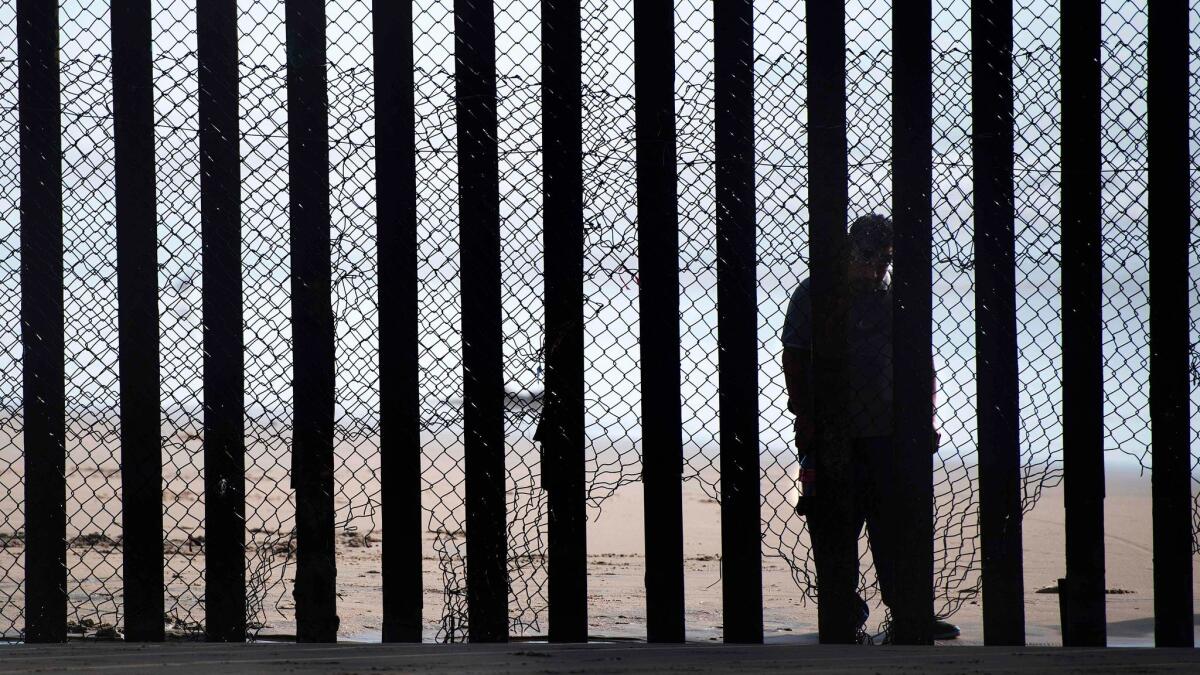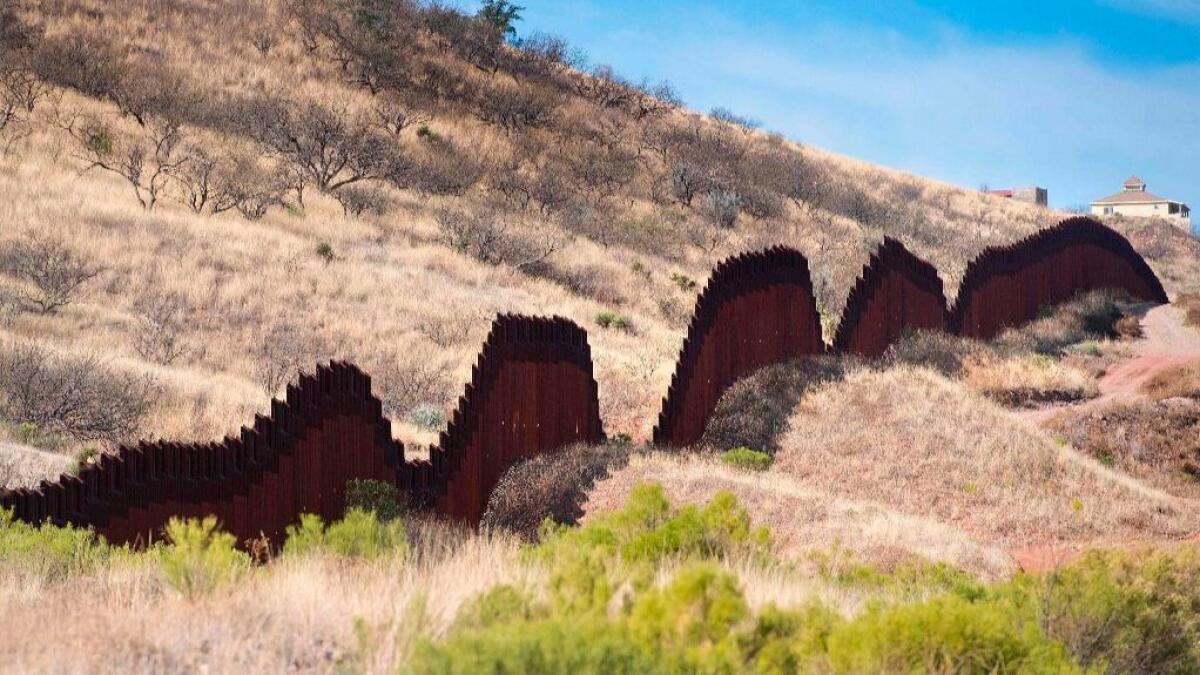Almost 100 California entities are interested in building Trumpâs border wall

International engineering corporations, boutique architectural firms and tiny mom-and-pop builders with names like âLoko-Kokoâ are lining up to help build President Trumpâs border wall, despite the fact that Mexico has said it wonât pay for it and polls show that many Americans donât want it.
Since the Department of Homeland Security placed a presolicitation notice on the Federal Business Opportunities website in late February for âthe design and build of several prototype wall structures in the vicinity of the United States border Mexico,â more than 600 interested vendors across the country have signed on, including almost 100 entities from California.
Kevin Rouhani of Meridian Precast Inc., a Westwood-based company that produces prefabricated walls and concrete panels and has worked on government infrastructure such as BART stations in the Bay Area, says he is keeping an eye on the specifications of the project to see if it might suit his company.
âAny big project in general that has some sort of potential, weâll follow and see if it has anything for us,â said Rouhani.
Halbert Construction of El Cajon, near San Diego, which has experience working with the federal government including projects at the U.S.-Mexico border, is also listed as an interested vendor. The company worked on a small pedestrian bridge that connects San Ysidro with Tijuana and built a small stretch of fence around the border station.
âIf itâs going to happen, we would like a piece of it,â said Halbert project coordinator Jimmy Benavente, shortly after the presolicitation was posted. âWe try not to bring our political beliefs into it.â
Certainly, the wall is one of the most politically divisive architectural projects to be proposed by a president.
At least six in 10 U.S. voters oppose it, according to a poll released by Quinnipiac University late last month. Rep. Will Hurd (R-Texas), whose district includes 800 miles of U.S.-Mexico border, came out against it. And on Tuesday, Sen. Claire McCaskill, a ranking member of the Senate Homeland Security and Governmental Affairs Committee, sent a letter to Homeland Security chief John F. Kelly, asking how the DHS planned to pay for the wall. (Budgets for the project have been estimated to run from $15 billion to $40 billion.)
That same day, Politico reported that the Trump administration was considering cuts to the Coast Guard and the Transportation Security Administration, among other agencies, to help fund the project â which drew an outcry from critics.
We try not to bring our political beliefs into it.
— Jimmy Benavente, Halbert project coordinator
And there has been the hastiness in the design process. The presolicitation stated that a more formal call for entries would go online on March 8 and that concept papers would be due four days later â providing 96 hours to design a prototype for what could serve as the model of one of the biggest infrastructure projects in American history.
This week, DHS slightly delayed and extended that deadline. The formal solicitation will instead go online sometime around March 15 and concept papers will be due five days later.
The revised post also noted that the government was seeking a wall that was ânominally 30 feet tall, that will meet requirements for aesthetics, anti-climbing, and resistance to tampering or damage.â
The mere mention of the word âaestheticsâ had the art and design types tittering on Twitter; a reporter for Talking Points Memo noted that the word may be a nod toward Trumpâs continual use of the words âbig, beautifulâ when describing the wall.
Regardless of how attractive it may look, the construction of the U.S.-Mexico border wall is no ordinary infrastructure project. Thereâs its massive scale. Trump wants a âcontiguous, physical wallâ along all 2,000 miles of border with Mexico â which means a whole lot of steel and concrete (not to mention construction jobs).
And thereâs a 47-year-old treaty with Mexico that dictates that no structure can interfere with the flow of cross-border waterways, such as the Rio Grande.
There are also the environmental concerns; a contiguous structure could affect more than 111 endangered species, as well as various wildlife refuges and protected wetlands.
For some in the design community, the wall has raised all kinds of ethical issues. Last year, the architectural website ArchDaily generated an outcry when it announced a competition titled âBuilding the Border Wall?â One architect called for a boycott of the site in response. Others wondered whether the competition encouraged xenophobia. And a lengthy piece in the New Republic explored whether the competition missed the point on the borderâs more pressing needs, such as municipal infrastructure for the informal settlements known as colonias.
Design and architecture writer Kriston Capps, who has been following the topic of the wallâs design and construction closely on the urbanism website Citylab, wrote in one essay that âany company (or companies) picked for the job faces a sincere reputational risk.â
ââNo Ban, No Wallâ has emerged as a rallying cry for Muslim and Latino communities and their allies at protests held across the nation,â he adds. âThe firm that wins the final [request for proposals] may also earn undesirable exposure from activists.â
The attention the project has received has made some companies press shy. One project manager at a small construction company in Alta Loma said, âIâm not sure itâs something we really want to engage in.â
Benavente says he tries to âlook pastâ the issue of politics: âItâs been a topic since the political race started and, in our office, political beliefs aside, we like to keep our doors open.â

And while itâs too early to talk design, he notes that itâs not going to be easy to build.
âA 30-foot building, thatâs not hard,â says Benavente. âBut a 30-foot-tall wall, thatâs another story. I could put it up on firm ground pretty easy. But if youâre dealing with desert or a lake bed, itâs going to get more difficult.
âItâs not like you take two pieces of wood, fill it with concrete and then weâre good,â he adds. âIt takes a lot more engineering than that.â
Rod Hadrian oversees Hadrian Construction in Carlsbad and he says the controversies surrounding the wall donât concern him much. âIâm an older gentleman,â he says, âI know cement.â
Heâs more interested in pitching a synthetic panel system employed by his company that might offer a more efficient construction method than pouring cement in place all along 2,000 miles of border.
Plus, thereâs his last name â which he shares with the Roman emperor who built a massive wall in what is now northern England. Heâs never visited Hadrianâs Wall, but he notes that his high school Latin teacher once gave him a passing grade based on his last name.
âIf I tried to market this, I could probably use my name,â he jokes.
One of the more unusual vendors to appear on the presolicitation list was a small, bicoastal design studio called JuneJuly, founded by architects Jake Matatyaou, who is based in Los Angeles, and Kyle Hovenkotter, in New York. Matatyaou is on the faculty at SCI-Arc, the Southern California Institute of Architecture in downtown Los Angeles; Hovenkotter teaches at Columbia University and the Pratt Institute, among others.
For both, the border is a long-running area of interest.
âWeâre interested in conversations around the future of cities, especially with respect to borders,â says Hovenkotter. âWe think we want to approach this project as honestly as we can.â
In the past, the pair has worked on a conceptual project, titled âApproaching Borders,â that tries to subvert the infrastructure of the border so that it becomes a point of linkage, rather than separation. For example: placing two-way video feeds at points along the wall so that people at the border can connect visually with people in other cities such as Washington, New York and Mexico City â a way of using the tools of surveillance to connect.
âIf we begin with the fact that weâre building a hard border, something physical and material, we start with the question, âWhat is an aesthetically aware, humanitarianly minded thing?â asks Matatyaou. âCan it have a more humane interface than something that is just technical and tactical and is about demarcation and territorialization?â
Are they concerned about the ethics of working on such a controversial piece of infrastructure?
âIn an ideal world,â states Matatyaou, âthere would be no border, and certainly, no wall.
âBorders already exist far removed from walls that circumscribe territorial boundaries,â he adds. âWalls, material or otherwise, exist within every American city.â
Adds Hovenkotter: âI take a post-national position. I think the nation-state is a kind of outdated construct. And I think they are creating more political problems than solutions. But I also understand that if there is a system in which to play, you might want to play in it and make the best of it.â
Whatever gets built, Benavente of Halbert notes that ânothing is going to be foolproof.â
âUnless youâre putting a wall thatâs 200 feet tall and 100 feet underground,â he says, âthere are people who are going to tunnel under or create mobile structures to advance over the top.â
Sign up for our weekly Essential Arts & Culture newsletter Âť
ALSO
Column: Build a wall? Trump should talk to the man who spent 25 years fixing it
On the other side of the wall: Mexicans on the border are âpsychologically traumatizedâ
Number of immigrants caught at Mexican border plunges 40% under Trump
More to Read
The biggest entertainment stories
Get our big stories about Hollywood, film, television, music, arts, culture and more right in your inbox as soon as they publish.
You may occasionally receive promotional content from the Los Angeles Times.











